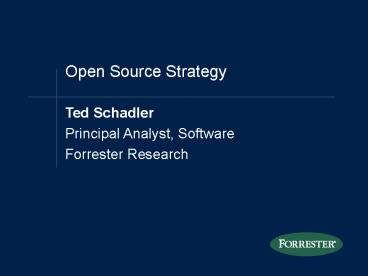Open Source Strategy - PowerPoint PPT Presentation
1 / 23
Title:
Open Source Strategy
Description:
What is open source and why is it different? Which open source products should you use? ... Build a managed deployment playbook. Treat Linux like commercial software ... – PowerPoint PPT presentation
Number of Views:104
Avg rating:3.0/5.0
Title: Open Source Strategy
1
Open Source Strategy
Ted Schadler Principal Analyst,
Software Forrester Research
2
Agenda
- What is open source and why is it different?
- Which open source products should you use?
- Where does Linux fit?
- What the best Linux deployment strategy?
3
Whats different about open source?
- Development the scientific method yields great
infrastructure software - Peer review
- Published results
- Coding volunteers
- Released by engineers
- Licensing typically free
- Support a broad array of choices
4
Open source works best for infrastructure
- The nature of quality is different for
infrastructure software - Low-cost
- Secure
- Rock solid
- Biggest user base means that coders are rewarded
most on infrastructure projects - Other software markets are too small or niche to
attract attention and expertise
5
Open source risks and rewards
Risks
Rewards
Low cost
High quality
Broad support
6
Open source business models
- Enhance, support, and distribute (Red Hat, SuSE,
Covalent, JBoss Group) - Use dual licensing to sell one version and give
one version away (mySQL, Zope) - Sell hardware (Dell, HP, IBM)
- Bundle in commercial software (BEA, IBM, Oracle,
Sun, many others)
7
Which open source products should you use?
8
Apply three open source filters
9
An open source deployment list
- Deploy with confidence
- Linux, Apache, Axis, Struts, PHP, Perl
- Representative watch list
- SAMBA, Tomcat, JBoss, mySQL
- Avoid in most situations
- Linux desktop. Open Office
10
Where does Linux fit?
11
Linux already has an enterprise foothold
12
Linux is more than ready for the enterprise
- The Linux kernel is more than ready for
enterprise workloads - Commercial support is readily available from
giants like HP, IBM, Oracle, and SAP - ISVs are busily porting their apps to Linux
- Intellectual property concerns are IBMs problem
-- not yours
13
Though mostly at the front of the datacenter
Where are you running Linux today?
44
40
26
24
6
Data
Client
Infra-
App
Web
structure
tier
tier
tier
tier
tier
Base 50 1B companies using Linux
(multiple responses accepted)
14
Whats the best Linux deployment strategy?
15
Linux will tip in the datacenter in 2003
Linux server loads
The Linux tipping point
Commercial support from high-tech giants
Falling technology barriers
Unix reliability at Intel prices
2001
2007
2003
2005
16
Beware of chaos, cost, and complexity
- Too many Linux distributions -- and
configurations - Too many hardware configurations
- Too much Linux outside the datacenter
17
A managed deployment strategy
Building a shared server pool by automating
server procurement and operation
18
Mastering managed Linux deployment
- Build a managed deployment playbook
- Treat Linux like commercial software
- Create cookie-cutter configurations
- Plot a migration roadmap
- 2003 Web servers, email, infrastructure
- 2004 Portals, call centers, commerce sites
- 2006 Core transaction systems
- Assemble a vendor portfolio
19
Assemble a vendor portfolio
- Bet on a single distribution
- Red Hat (North America)
- SuSE (Europe, mainframe, desktop)
- Choose a primary and secondary hardware supplier
(Dell, HP, IBM) - Invest in provisioning and management
- Pure Linux LinuxCare, Covalent, Red Hat
- Heterogeneous HP, Opsware, Veritas
20
Server market dynamics in 2003
21
Linux hollows out the server market by 2007
Percentage of new workloads
Intel
Mainframe- class
RISC
22
So what can go wrong?
- IP lawsuits may continue to ramp up
- IBM will intervene to solve this problem
- ISVs, worried about IP issues, may slow their
porting efforts - Get started with Linux where its a proven
winner Web servers, email, file print - Sun may Solaris-ize Linux -- igniting another
round of the Unix wars - GPL licensing comes to the rescue
23
Thank you
Ted Schadler 1 617/613-5975 tschadler_at_forrester.c
om www.forrester.com

